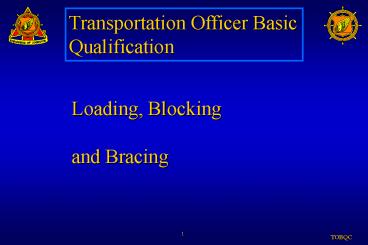Loading, Blocking - PowerPoint PPT Presentation
1 / 28
Title:
Loading, Blocking
Description:
On chain devices, secure open-faced. hooks to chain link with wire or nylon. tie strap. ... Distribute check lists on page 28 and C-11 (for 40000 series M1 ... – PowerPoint PPT presentation
Number of Views:176
Avg rating:3.0/5.0
Title: Loading, Blocking
1
Transportation Officer Basic Qualification
Loading, Blocking and Bracing
2
References
FM 55-65, Strategic Deployment FORSCOM/ARNG
Regulation 55-1, Unit Movement Planning MTMCTEA
PAM 55-19, Tie-Down Handbook for Rail
Movements TB 55-46-1, Standard Characteristics
for Transportability of Military Vehicles and
Other Outsize/Overweight Equipment TM
55-2200-001-12, Application of Blocking, Bracing,
and Tie-down Materials for Rail Transport
3
Preparing Unit Equipment for Rail Movement
- The deploying unit is responsible for preparing
its equipment for rail movement
4
Preparing Vehicles Prior to Loading
- Vehicle Preparation Requirements
- All lifting tiedown shackles attached to
vehicles
- Fuel tanks no more than 3/4 full
- Canvas and bows removed or banded
- Windshields Protected
- Reduce vehicle configuration based on information
contained in movement order
5
Preparing Vehicle Prior to Loading (Cont)
- Secure any materials or equipment
- Bands must be approved by AAR.
- Ensure that hood latches are functional and
secure.
- Check all tire inflation and condition.
6
Vehicle and Equipment Loading
- Prior to loading, stage vehicles in the order
they - will be loaded
- Most common loading procedure is
- circus method
- Flatcars equipped with spanners used as
- roadbed
- All vehicles loaded on rearmost car, then
- moved forward to assigned locations
7
Loading
- Prior to loading the vehicle onto railcar, all
personnel with the exception of the driver must
dismount vehicle
- Vehicles move to position after previous vehicle
is loaded and rail car cleared.
8
Loading (Cont)
- Ensure spanners are properly positioned capable
of supporting the heaviest load anticipated
- At least 12 of spanner should overlap the rail
car deck
- Most track vehicles dont require spanners
between rail cars
9
Loading (Cont)
- Car guide should be one car ahead of vehicle or
positioned not to be caught between vehicles
- Car guides escort all vehicles onto ramp and
railcar, and use proper hand and arm signals.
- Car guides stay in clear view of driver at all
times.
10
Loading (Cont)
- When driving on spanners, maintain a constant
speed.
- Avoid jamming on brakes or reversing
11
Vehicle Spacing
- Vehicles require a minimum of 10 inches of space
between vehicles.
Good 45o Bad Spacing
12
Setting Vehicles
- After positioning vehicle on railcar, vehicle
- operator
- Places transmission in neutral
- Sets parking brake
- Places battery switches in off position
13
Tie-down Procedures
- When securing vehicles use these techniques.
- Inspect chain assemblies
- and components.
- Apply chains in pairs
- Turntable type winches
14
Tie-down Procedures (Cont)
- Ensure proper wire or chain tension
- Place tension on
- wire rope to allow no more
- than one inch
- deflection.
15
Tie-down Procedures (Cont)
- Secure excess wire rope to the
- tension bearing part of the wire rope.
- On chain devices, secure open-faced
- hooks to chain link with wire or nylon
- tie strap.
- Lock chain-tightening device with wire.
- Turnbuckles must have jamnuts tightened
- wrench-tight using two wrenches
16
Tie-down Procedures (Cont)
- Secure chain through tie-down points at
- forty-five degree angle.
- Pull chain tight as
- possible, ensuring
- that there are no
- twists or kinks, and
- secure chain hook
- to chain.
17
Tie-down Procedures (Cont)
- Hand tighten turnbuckles first, then
- continue to tighten with open end or
- crescent wrench until 1/8 inch of the
- rubber compression ring shows.
- Store used chain assemblies in the
- rail car channel
18
MTMCTEA PAM 55-19
- Appendix B provides wire tie-down procedures
- Appendix C provides chain tie-down procedures for
the transport of military vehicles
- Distribute check lists on page 28 and C-11 (for
40000 series M1 tank) tie-down procedures
19
Three Axle Vehicle -- Chain Tie-down Illustration
- Alloy Steel
- Chain
- MTMCTEAPAM 55-19 Appdx C page C-3
20
Blocking and Bracing Materials
- Blocking bracing references contained in both
TM 55-2200-001-12 MTMCTEA Pam 55-19
21
Three Axle Vehicle -- Wire Tie-down Illustration
- 6 X 19 WRC IPS Wire Rope
- MTMCTEAPAM 55-19 Appdx B, page B-4
22
Final Inspection
- Final inspection is made after the railcars
- are loaded to ensure that the contents are
- loaded, blocked and braced in compliance
- with AAR loading rules.
- The rail representative
- is the final approving
- authority for accepting
- rail loads.
23
(No Transcript)
24
On Learning
25
On Learning
Question 1 What reference provides a checklist
for loading and tying down unit equipment on rail
cars?
Answer 1 MTMC TEA Pam 55-19, Tiedown Handbook
for Rail Movements
26
On Learning
Question 2 What is the minimum amount of space
that must be maintained between vehicles that are
secured to the railcar deck?
Answer 2 AAR rules require a minimum of 10
inches between vehicles.
27
QUESTIONS ???
28
U M O D P C
Break
10 mins































